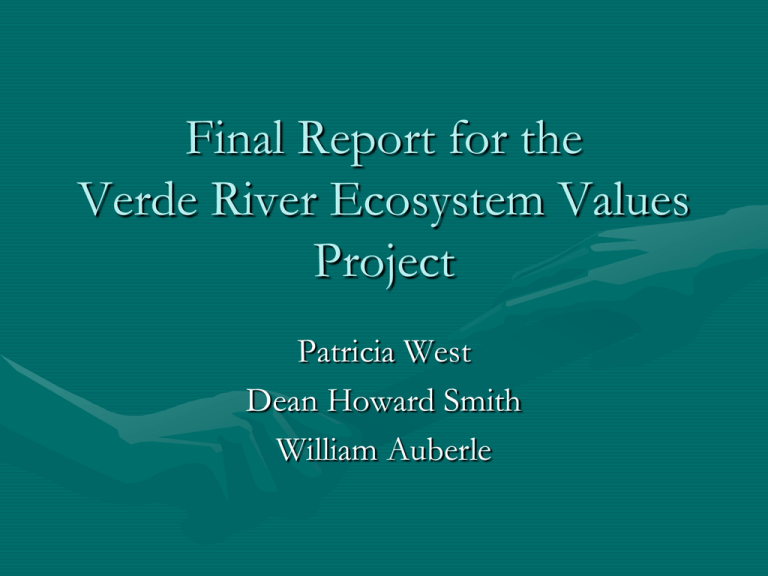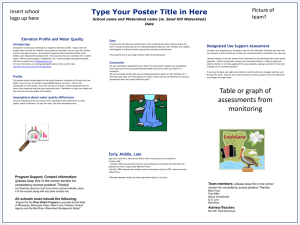Final Report for the Verde River Ecosystem Values Project
advertisement

Final Report for the Verde River Ecosystem Values Project Patricia West Dean Howard Smith William Auberle The Verde River Watershed The Verde • • • • 1,323 to 12,617 feet above sea level , 6,622 square miles, over 9,037 mile of streams, but “only 6% (578 miles) of streams are perennial, and are mostly restricted to the main stem of the Verde River” A Special Place in the West • Unlike many rivers in the West, most of the watershed is unregulated (no significant dams) and thus retains a natural flood regime • Possesses one or more specific ‘outstandingly remarkable values’ • The 40.5-milesection of the Verde River between Beasley Flats and Sheep Bridge – This stretch of river is the only designated “Wild and Scenic” river in Arizona Why the concerns? • Human uses and climate conditions affect the base flow and have both contributed to declines in the base flow since 1994 (Springer and Haney 2008). • Decreases in base flows can produce many effects on people, flora and fauna, and ecological processes in the Verde River Watershed. • One of the changes predicted is a decline in cottonwood and willow abundance (Haney et al. 2008). Pollution Issues • “The primary sources for nonpoint source pollutants concerns in the Verde Watershed include abandoned mine sites, new development and increased urbanization, and new road construction.” • Other threats to the watershed included livestock grazing (Fossil Creek and Cherry Creek), animal wastes and failure of residential septic systems Flora • There are no federally-listed, rare or endemic plant species known to occur in riparian areas in the watershed (Stromberg 2008). • The one federally-listed threatened endemic plant in the watershed is the Arizona Cliffrose (Purshia subintegra) that has a range limited to a few small limestone outcrops in the Verde Valley. • But there are serious ecosystem challenges. Fauna - Birds • Over 248 species of birds • Home to two endangered bird species: – Desert Nesting Bald Eagle – Southwestern Willow Flycatcher; • Home to the Western Yellow-billed Cuckoo which is a candidate species for listing Fauna - Fish • Historically, at least 13 natives fish species occurred in the Verde River basin • 4 Federally listed – – – – Razorback sucker Gila chub Spikedace Loach minnow • 1 candidate for listing – Roundtail chubs Fauna - Mammals • 92 species of mammals call the Verde River Basin home • Bats and rodents, as well as the more commonly sighted mule dear, elk, bear, raccoon, skunk, etc. • Beaver, river otter and muskrat are obligate aquatic mammals and rely solely on riparian habitat. • The Arizona River Otter is a species with limited distribution Fauna - Other • Some groups are mostly unnoticed or considered pests by some and their importance is often underestimated. Two of these groups are the invertebrates herpetofauna (reptiles and amphibians). Protected species in these groups are present in the Verde River Watershed. • Human and domesticated Challenges to the Verde River • In 2006, American Rivers pronounced the Verde River as the 10th Most Endangered River in the United States • 132,000 in 2000 to over 260,000 in 2050 • Regional drought persists and creates concerns for water sustainability throughout the state and the region. Methodology • • • • • • • Literature Review Development of Interview Questions Interviews Rubric Development Rubric Implementation Data Analysis and Validation Conclusions Rubric One • Use – Play today • Option – Play tomorrow • Non-use – Never play, but value As discussed in the literature review, any such classification will have fuzzy boundaries between categories. Ecosystem Services and Their Links to Human Well-being (Millennium Ecosystem Assessment 2003 Rubric Two • Supporting – Soil formation • Provisioning – Taking stuff • Regulating – Water cleansing and pollution mitigation – Microclimates (cooling) • Cultural – Interacting - very broad Determining Values • How do you use the river? – – – What plants and animals that rely on the river are important to you? Do you collect or use any plants or animals that rely on the river? If so, which ones? Do you have a spiritual, religious, or personal connection to the river? If so, could you describe this connection? What and Why Explanations Determining Values • What functions, processes or services does the Verde provide that are important to you and the community? (e.g. flooding, filtration, seed dispersal…) What and Why Data Sorting • 35 interviews – Not a random sampling • Nearly 500 responses • Two stage sorting • Validation by second team member Flora and Fauna • • • • use category. then mostly placed into the provisioning section. even when it was clear that a particular comment fit into several categories. habitat provisions of a particular animal or plant (or flora and fauna in general) were listed as non-use and regulating. • Specific comments regarding protected species (including federally-listed threatened and endangered species) could easily be listed under numerous categories, but were generally placed under use and cultural. The ability to witness a Bald Eagle is a current use that allows the participant to take the experience from the watershed. Many respondents also itemized a spiritual or other cultural value to having Bald Eagles living near the river. Clearly, most respondents also view this as an option value, and most, if pressed, would also call it a non-use value. Table A Place not a Thing • Strongest conclusion from the analysis is that people value the river as a place and not just a thing. • It is not simply a thing where they acquire goods and services; rather it is a place where they do activities. • The ability to use the watershed as a source of water is vitally important. • Less than 40% of the responses can be listed as provisioning, and, of that number, most involve aspects and items beyond simple water provision. Part of the Local Culture • There were more replies that can be categorized as cultural than those listed as provisioning. Although very broad in scope – from spiritual to educational – the cultural category includes all the reasons people view the watershed as a place to interact with, as opposed to a thing from which to take resources. A Thing to Continue • Although the numerical count of the regulating values is small, the respondents were very familiar with the idea of looking at the watershed as a connected system and even a system of systems. • Furthermore, the non-use aspects of regulating values shows how people view the importance of the watershed as a watershed. • The importance of habitat preservation and the biodiversity of the area are highly valued. At both the micro and macro levels the ecosystems within the watershed are critical. • As an area that sustains otters and as a stopover on the flyways of migrating birds, people wish to protect the watershed. Valued Places • A geographical lesson for an adventure map of the Verde River Watershed • The relevant question specifically included the descriptor “watershed” instead of “river.” • Easy public access and wild places. • Historical and archeological places • Several respondents requested secrecy Valued Places • Sedona, Oak Creek Canyon, the Beaver Creeks, Montezuma’s Castle and Well National Parks Monuments, Arizona State Parks in the region (Verde River Greenway State Natural Area, Dead Horse Ranch State Park, Red Rock State Park, Slide Rock State Park, Fort Verde State Historic Park), Windmill Park, and Tuzigoot National Monument. Threats to the Watershed • 26 individuals were concerned about the amount of pumping taking place from the aquifer and withdrawals from the river • Twenty-three of the thirty-five respondents itemized some aspect – in many cases several aspects – of the growth of the Verde Valley and environs. Threats to the Watershed • 18 of the 35 interviewees included some aspects of pollution as threats to the river. • Invasive species were a concern of eight of the respondents. • Six interviews specifically itemized that climate change is a threat to the river. Not the most important, just the most frequent. Conclusions and Recommendations • Not representative of the general population of stakeholders living and working within the watershed. • A series of public forums and workshops can be developed to educate both stakeholders and decision makers within the region. • The ongoing scientific and policy research should be continued, expanded, and coordinated. Conclusions and Recommendations • The sustainable access to potable water is vital to the sustainability of the human and nonhuman population of central Arizona. • The importance of understanding both the science and policy issues concerning the watershed cannot be understated. What Patty and Dean think • We can conclude that the Verde River and its watershed are valued in a multitude of ways. Putting monetary value on these values may be desired in order to make the value of some ecosystem services clear to all stakeholders, but valuation is not necessary to show that the stakeholders value the river itself, not just what it can give to them (i.e. water etc.). Water and fish have meaningful market values, but an eagle or otter does not. Second Data Scrub • “Determinants and Constituents of Well-Being” (shown in figure 2) using the categories of security, basic materials for a good life, health and good social relations. This type of analysis would help in explaining not only “what” is important about the watershed, but also “why” it is important.





